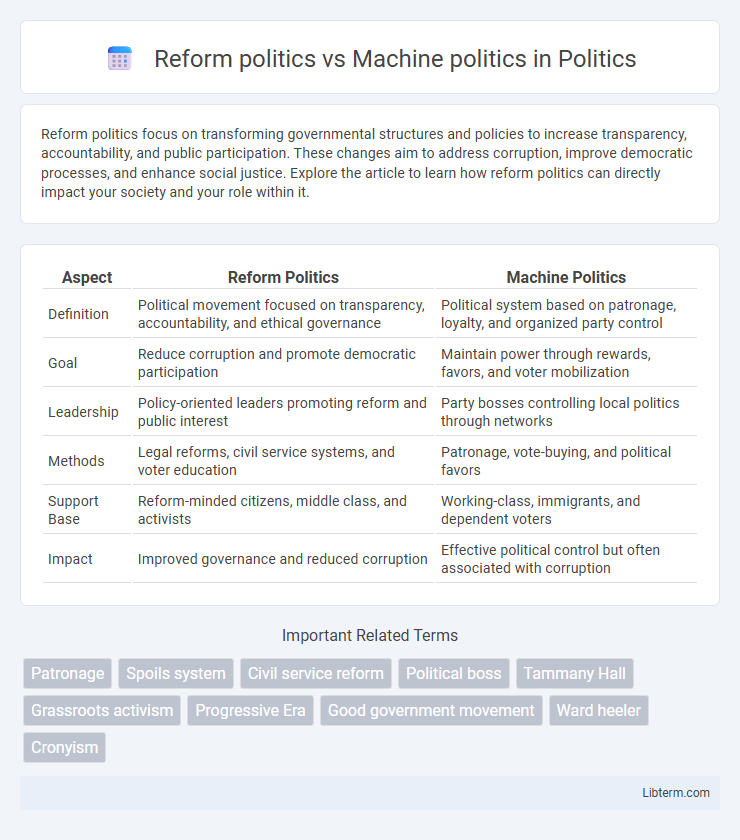Reform politics focus on transforming governmental structures and policies to increase transparency, accountability, and public participation. These changes aim to address corruption, improve democratic processes, and enhance social justice. Explore the article to learn how reform politics can directly impact your society and your role within it.
Table of Comparison
| Aspect | Reform Politics | Machine Politics |
|---|---|---|
| Definition | Political movement focused on transparency, accountability, and ethical governance | Political system based on patronage, loyalty, and organized party control |
| Goal | Reduce corruption and promote democratic participation | Maintain power through rewards, favors, and voter mobilization |
| Leadership | Policy-oriented leaders promoting reform and public interest | Party bosses controlling local politics through networks |
| Methods | Legal reforms, civil service systems, and voter education | Patronage, vote-buying, and political favors |
| Support Base | Reform-minded citizens, middle class, and activists | Working-class, immigrants, and dependent voters |
| Impact | Improved governance and reduced corruption | Effective political control but often associated with corruption |
Understanding Reform Politics: Principles and Goals
Reform politics centers on transparency, accountability, and the elimination of corruption, aiming to create a more equitable and efficient government system. Its principles emphasize citizen participation, merit-based appointments, and the implementation of ethical standards to replace patronage and graft prevalent in machine politics. The goal is to promote democratic governance by reducing the influence of political machines that rely on loyalty and vote-buying.
Defining Machine Politics: Structure and Operation
Machine politics operates as a hierarchical political organization relying on a central authority to control votes and maintain power through patronage and incentives. Its structure consists of tightly knit networks of local leaders and ward bosses who mobilize voters by exchanging services and favors for political support. This system thrives on loyalty, centralized control, and the distribution of tangible benefits to constituents in exchange for electoral backing.
Historical Evolution of Reform and Machine Politics
Reform politics emerged in the late 19th and early 20th centuries as a response to the corruption and patronage systems entrenched in machine politics, which dominated urban governance through organized party control and loyalty networks. The Progressive Era marked a significant shift, promoting merit-based civil service, transparency, and voter empowerment to dismantle the power of political machines like Tammany Hall. Over time, reform politics sought to replace machine-driven elections with institutional reforms such as primary elections, nonpartisan ballots, and regulatory oversight to enhance democratic accountability and reduce factional dominance.
Key Differences Between Reform and Machine Politics
Reform politics emphasizes ethical governance, transparency, and reducing corruption by promoting merit-based appointments and citizen engagement, whereas machine politics relies on patronage, loyalty networks, and hierarchical control to maintain political power. Machine politics often leverages voter manipulation, including vote-buying and favors, contrasting sharply with reform politics' focus on legal and institutional changes to improve democratic processes. The key difference lies in reform politics' goal of systemic change to enhance accountability, while machine politics prioritizes maintaining entrenched power structures through informal, often opaque means.
Notable Figures in Reform vs Machine Politics
Notable figures in reform politics include Robert La Follette, known for championing progressive legislation and fighting political corruption in the early 20th century. In contrast, William M. Tweed, leader of Tammany Hall, epitomized machine politics through his control over New York City's political machinery and use of patronage. These figures highlight the ideological and operational differences between reform-driven agendas and entrenched political machines prioritizing loyalty and control.
Impact on Governance and Public Policy
Reform politics prioritize transparency, accountability, and citizen engagement, leading to governance that promotes equitable public policies and reduces corruption. Machine politics often rely on patronage networks and centralized control, which can result in short-term policy decisions favoring special interests over public welfare. The impact on governance differs significantly, with reform politics fostering long-term institutional integrity and machine politics perpetuating inefficiency and policy inconsistency.
Corruption and Accountability: A Comparative Analysis
Reform politics emphasizes transparency, strict anti-corruption measures, and institutional accountability to reduce graft and promote ethical governance, while machine politics often relies on patronage, vote-buying, and opaque networks that foster systemic corruption. In reform politics, mechanisms such as independent watchdog agencies and open electoral processes enhance responsibility, contrasting with machine politics' reliance on hierarchical control and loyalty over public interest. The comparative analysis highlights reform politics' potential to curtail corruption through legal frameworks and civic engagement, whereas machine politics perpetuates accountability deficits through clientelism and entrenched power structures.
Grassroots Movements and Political Machines
Grassroots movements emphasize citizen participation and local engagement to challenge entrenched political machines that rely on centralized control and patronage networks. These movements leverage community organizing, direct voter contact, and issue-based campaigns to disrupt traditional political machines' influence and promote transparency. Political machines maintain power through hierarchical structures and reciprocal favors, often resisting reform efforts that threaten their dominance.
Electoral Outcomes: Reformists vs Machine-backed Candidates
Reform politics often emphasize transparency, accountability, and grassroots mobilization, resulting in candidates who appeal to independent and undecided voters. Machine politics rely on organized, loyalty-based networks providing reliable votes through patronage and voter mobilization, which can secure consistent electoral victories in urban areas. Electoral outcomes frequently show reformist candidates gaining momentum in closely contested or changing demographics, while machine-backed candidates dominate in entrenched political environments with established voter blocs.
The Future of Reform and Machine Politics in Modern Society
Reform politics, emphasizing transparency, accountability, and citizen participation, increasingly contrasts with machine politics' reliance on patronage networks and centralized control. Urban governance trends suggest reform efforts will leverage technology and data-driven platforms to diminish machine politics' influence and foster democratic engagement. However, the resilience of machine politics in certain regions indicates a complex future where hybrid models may emerge, blending reform ideals with pragmatic political strategies.
Reform politics Infographic

 libterm.com
libterm.com